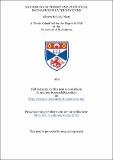Files in this item
Random-walk theory and statistical mechanics of lattice systems
Item metadata
| dc.contributor.advisor | Farquhar, Ian E. | |
| dc.contributor.author | Nieto, Alberto Robledo | |
| dc.coverage.spatial | 98 p. | en_US |
| dc.date.accessioned | 2018-06-05T11:02:23Z | |
| dc.date.available | 2018-06-05T11:02:23Z | |
| dc.date.issued | 1974 | |
| dc.identifier.uri | https://hdl.handle.net/10023/13722 | |
| dc.description.abstract | It has been found elsewhere that when approximate relations for the two-particle correlation functions of classical statistical mechanics, such as the Percus-Yevick and the mean-spherical approximations, are applied to the lattice gas models with nearest-neighbour interactions simple expressions are obtained for the total correlation function in terms of the lattice Green's function. Since many of the properties of random walks on a lattice can be described by the lattice Green's function, it follows that these systems, at least when treated under these approximations, may be analysed in terms of the language of random walks. Here the theory of random walks on lattices is appropriately extended to show that the relationship between the correlation functions and the lattice Green's function is not dependent upon the employment of these approximations, nor to a particular range or form of the potential function. Instead, this relationship is shown to be an alternative form of the Ornstein-Zernike relation between the direct and total correlation functions. The direct correlation function is directly related to the probability of a single step, whereas the total correlation function is given by the first-passage- time probabilities of the random walks. Thermodynamic properties, such as the isothermal compressibility, are also interpreted in terms of random-walk concepts. The random-walk formulation is then extended to include the study of ordered phases in lattice-gas models and hence order-disorder transitions in these systems. Also, an asymptotic form for the lattice Green's function is derived to illustrate how the form of decay of the total correlation function at large distances depends on the properties of the potential function. To show that the random-walk interpretation of the Ornstein-Zernike relation is not restricted to lattice systems, we define analogous random-walk functions for continuous space. These lead to a straight-forward generalization of most expressions for discrete space-; the relationship between the continuous-space total correlation and Green's functions has the same form as that for the lattice systems. We also explore the possibility of obtaining random-walk properties of a (lattice or continuous-space) system, not from the existing approximate expressions for the direct correlation function, but instead from a generalised Ornstein-Zernike relation based on a maximum principle of classical statistical mechanics. Finally, we choose a few specific lattice-gas models to show how the method describes their different properties, such as the behaviour of the total correlation function or that of an order- disorder phase transition. | en_US |
| dc.language.iso | en | en_US |
| dc.publisher | University of St Andrews | en |
| dc.subject.lcc | QA171.5R7 | |
| dc.subject.lcsh | Group theory | en |
| dc.title | Random-walk theory and statistical mechanics of lattice systems | en_US |
| dc.type | Thesis | en_US |
| dc.contributor.sponsor | Universidad Nacional Autónoma de México | en_US |
| dc.type.qualificationlevel | Doctoral | en_US |
| dc.type.qualificationname | PhD Doctor of Philosophy | en_US |
| dc.publisher.institution | The University of St Andrews | en_US |
| dc.publisher.department | Department of Theoretical Physics | en_US |
This item appears in the following Collection(s)
Items in the St Andrews Research Repository are protected by copyright, with all rights reserved, unless otherwise indicated.

